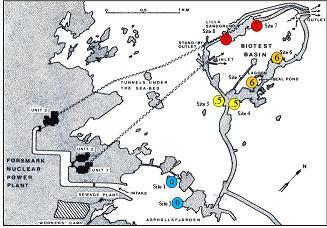Materials and Methods

Field work
The field work was carried out from 27 June until 14 July 2011. Colonies of Rivularia were collected from natural stones at Stations 1-8. Micrographs of Rivularia and its epiphytes were taken. Photosynthetic activity (chlorophyll fluorescence) was measured immediately after sampling using a Diving-PAM. Three replicate samples were measured from each site. P-I curve (photosynthesis versus photon irradiance curve) were produced according to Henley (1993).
Experimental incubations of Rivularia
For the laboratory experiment with Rivularia, field samples were collected from natural stones from Site 2 (Figure 1). The experiment was performed in three climate chambers in which temperature was held constant at 18, 22 and 26°C, respectively (Figure 4). The cultures were illuminated in a 18:6 h L:D regime. This is comparable to the natural day-night regime in the Forsmark area during summer. The acclimatization period of the laboratory experiment was from 15 July 2011 until 24 July 2011. The experiment was started on 25 July 2011 and ended after 50 days on 12 September.
Responsible for this page:
Director of undergraduate studies Biology
Last updated:
02/10/13
